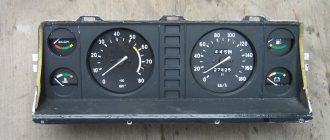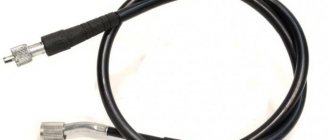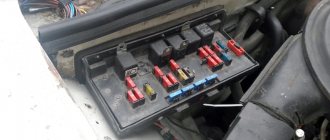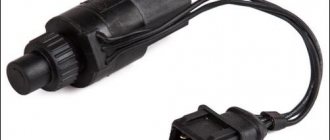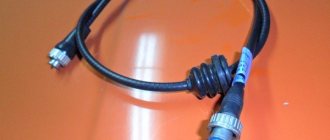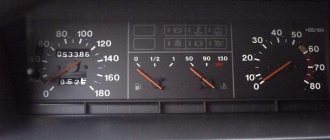In order to replace the speedometer drive on a “classic”, you will need several wrenches (10, 13) and a lift or inspection ditch.
The sequence of operations for replacing the drive is given below. Each number in the image corresponds to a step in the list. The work is performed sequentially and takes about 20 minutes.
- Using a 13mm wrench, unscrew the bolt of the clamp securing the exhaust pipe of the muffler to the gearbox.
- Unscrew the nut securing the flexible shaft of the speedometer drive.
- Using a 10mm wrench, unscrew the drive fastening nut.
- Using a 13mm wrench, unscrew the two nuts securing the cross member to the body. Then we lower the rear of the transmission down so that the studs come out of the crossmember holes.
- We shift the gearbox to the right and remove the speedometer drive from the hole in the crankcase.
We install the new drive in the reverse order of removal.
To replace the flexible shaft (cable), disconnect the upper fastening of the drive cable from the speedometer and remove it from the hole in the front body panel.
What is the difference between the speedometer drive of the VAZ 2101, 2103, 2106?
Depending on the gear ratio of the rear axle gearbox, speedometer drives can be of three types. They differ in the number of driven gear teeth (12, 9, 13).
One of the rarest, almost “extinct” on the auto parts market is the 2101 drive without a mark with 12 teeth. It is suitable for Zhiguli gearboxes with a rear axle 2101, which has a gear ratio of 4.3. The VAZ 2102 station wagon (gearbox – 4.44) is also installed on older models, but has a larger reading error (“overestimates”).
Drive 2103 (9 teeth) is marked with red paint - for a gearbox with rear axle 2103 with a gear ratio of 4.1.
The most popular option nowadays is the VAZ 2106 drive with 13 teeth, which has a blue mark on the body. Suitable for classic VAZ car models with axle 2106 (main gear ratio - 3.9).
How much does a new drive cost?
In auto stores in Moscow and the region, the average price for a speedometer drive is about 300 rubles.
SPECIALISTS ANSWER
NIKOLAI OVCHINNIKOV – HEAD OF THE STEERING FINISHING BUREAU; ALEXEY KLIMENKO – ENGINEER, TRANSMISSION DEVELOPMENT DEPARTMENT; VYACHESLAV VLASOV – LEADING ENGINEER OF THE TRANSMISSION DEVELOPMENT DEPARTMENT; ANATOLY ABEZIN – CONSTRUCTION ENGINEER, SUSPENSION KB.
Is it necessary to check the oil level in the steering gear housing of the “classic” and, if so, how to do it?
Actually, you don't need to do this. But if a leak is detected or there are any other reasons for doubt, the amount of oil in the crankcase is easy to check. Its level should be under the lower cut of the filler plug.
Does it make sense to use bearings in swingarms?
Certainly! Bearings (in this case, sealed ones are used) instead of nylon bushings, albeit slightly, do reduce the effort required to turn the steering wheel. At the same time, the rigidity of the trapezoid increases slightly, which has a positive effect on the stability and controllability of the car. The plant used this design on the new Niva VAZ-2123.
On the VAZ-21074, first and reverse gears are difficult to engage from time to time. It is sometimes impossible to even turn them off when the engine is not running and the car is stationary - only when moving. Replacing the clutch didn't help.
Most likely the cause is the transmission input shaft front bearing, which is mounted at the rear end of the engine crankshaft. It is possible that the bearing jamming creates the effect of a partially disengaged clutch and makes it difficult to shift gears, including if the engine is not running and the car is stationary. This is especially noticeable when using the lowest gears - reverse and first, when the rotational resistance is maximum.
Are there rear suspension springs for the VAZ-2115 sedan? If you believe the catalog, then VAZ-2108-2912712 springs are installed on it. But could it be that the VAZ-21099 weighing 940 kg has original springs, but the “fifteenth” weighing 985 kg does not?
In stores and on the market they often offer supposedly “ninety-ninth” rear springs. This is either a deception or a delusion. According to the documentation, all Samaras (from 2108 to 2115) have only “eighth” springs in the rear suspension. There are two options: the first, “high” - for the domestic market and “low” - for export. Each option is divided into two classes - A (“hard”) and B (“soft”). All springs are painted white, and differ in the color of the applied marks. For Russia: class A - yellow mark, class B - green. For export, respectively, A is brown, B is blue.
Replacing the speedometer drive
But at first I just thought that the drive was faulty, I counted the teeth (luckily only the middle was ground down), there were 13 of them, as in principle on all cars of this model with a five-speed gearbox, I bought a new one and installed it.
Imagine the surprise when, after a couple of kilometers, the speedometer failed again. Having removed the drive again and contrived, he looked into the hole in the box, while turning the shaft. It turned out that there was a problem.
I’ll write about how to change the speedometer drive drive gear in another article, but for now about replacing the drive.
Where is the Charging Relay for VAZ 2107 Injector
where is the relay exercise on the VAZ-2107
As a rule, engine starting problems are observed in winter if the VAZ-2107 is left outdoors overnight. This can happen for a variety of reasons, however, when the battery light flashes on the device panel, you should first suspect a problem with the charge relay . In most cases, such drivers encounter drivers who often poorly maintain their vehicle.
How to change the charging relay on a VAZ-2107, also where it is
? This article is responsible for this decision.
How does a baton work?
This device is on a VAZ-2107
(both carburetor and injector
) is located in the same housing as the brush mechanism.
Its main purpose. stabilize the voltage at the generator output. More recently, relays designed as electrical circuit boards have been sold in stores. There was one drawback. relatively short life expectancy. Such devices cannot be disassembled and simply replaced with serviceable ones if they break down.
Types of drives
When purchasing a drive, you still need to be careful. It is advisable to first remove the drive and count the teeth, since their number varies. There are several types of them: 9, 12 and 13 teeth. The installation of one or another drive depends on the installed rear axle, since they have different gear ratios. The 13 teeth are color coded blue.
If you are one hundred percent sure that the drive is faulty, then buy it. But I still recommend that you first figure out the reason why the speedometer is not working and only then make a purchase.
How to check the speed sensor
Speed sensor connector pin numbers
You can check the sensor without removing it from the car. To do this, connect the device as indicated in point “4” and rotate the shaft using the rear wheel. 1. Select a plastic tube of suitable diameter to fit tightly on the sensor axis. 2. Turn on the multimeter in DC voltage measurement mode; the measurement limit is 20 volts. 3. Connect the sensor to the car’s standard connector. 4. Connect the “positive” probe of the multimeter to contact “3” of the sensor, and the “negative” probe to ground. 5. Rotate the roller with a tube and look at the device. If the readings vary from approximately 0 to 5 volts, the sensor is working. You'll have to look for the problem elsewhere.
If there are no signals (changes in readings), we replace the sensor with a new one, suitable for the VAZ-2107. To check without a multimeter, you need to hook up the “control” (or any homemade 12-volt light bulb) with one wire to contact “3” of the sensor, and the other to “ground” and rotate the roller. If the speed sensor is working properly, the light will start flashing.
Replacing the seven speedometer drive
- in order to remove the part from the box, you need to lower it a little by unscrewing the nut 13 securing the box;
- use a 10mm wrench to unscrew the drive;
- Pull it out a little and turn it to disconnect the connector and unscrew the speed sensor.
- We pull out the part to the end.
Unscrew the box fastening
Unscrew the speedometer cable
Unscrew the speed sensor
Assembly is carried out in reverse order.
Reinstalling the speedometer drive
Note
Now there are still enough fakes on the market, and in order not to buy a low-quality part, check it at least a little. To do this, grab the gear on one side and the output on the other and try to turn it. If the engagement slips, it is better to refrain from such a purchase.
Operating principle
The injection motor operates under the control of a complex electronic system. Only the interaction of all sensors allows such an engine to be operated without problems. The speed counting system also operates in this electronic circuit.
The electronic speed meter consists of the following components:
- EMF or speed sensor. It is an electromechanical part. This device works on the principle of creating electrical impulses from the interaction of a metal secondary shaft and an EMF magnet. When an additional gear tooth passes, the sensor closes, creating an impulse.
Some models are equipped with an electromechanical sensor. It doesn't have a magnet. The formation of electrical impulses occurs due to the transmission rotation of the gear on the drive rod. Rotation creates impulses based on the Hall device principle. - A network of wires connecting the EMF to the on-board computer. It is through this network that electrical impulses are transmitted from the sensor to the on-board computer.
- The receiver is a drive that is the main mechanism of the speedometer itself. The device receives already calculated signals from the ECU. Due to these impulses, the arrow is deflected by a certain angle.
This system is quite reliable. The maximum service life is at least 100 thousand km.
Basic speedometer faults
Malfunctions can be divided into two types:
- the speedometer does not show the current speed;
- The speedometer drive is noisy.
The VAZ 2107 speedometer may not work for the following reasons:
- The speedometer is faulty. In this case, the device must be replaced.
- The nuts securing the ends of the flexible shaft have come loose. To fix the problem, they need to be screwed on.
- The flexible shaft is broken. It must be replaced to restore the speedometer's functionality.
- The tip of the flexible shaft or the mating socket on the speedometer is damaged. In this case, you should change the VAZ 2107 speedometer cable or the speedometer itself
- The flexible shaft drive is faulty or the speedometer drive socket in the gearbox is damaged. This is a rare breakdown, the elimination of which involves repairing the gearbox and is worthy of description in a separate article.
The VAZ 2107 speedometer drive can make noise for two reasons:
- The drive is laid with small bending radii. To fix the problem, you need to re-route the speedometer cable, having previously lubricated it.
- The braiding of the VAZ 2107 speedometer cable is damaged. In this case, the flexible speedometer drive assembly needs to be replaced.
As practice shows, most malfunctions are related specifically to the VAZ 2107 speedometer cable and can be eliminated by replacing it.
Causes of breakdowns
The causes of breakdowns are usually associated with mechanical damage to one of the drive parts, but some malfunctions can occur due to contamination or lack of lubrication. The main manifestations and signs of a malfunction will help you diagnose the specific cause of the breakdown.
- If the arrow lies at zero and does not respond to acceleration, then, most likely, a broken drive cable is to blame for the breakdown. In this case, it will have to be replaced. However, such a malfunction can also be caused by other reasons, for example, a loosening of the nut securing the flexible shaft to the speedometer. In this case, a simple tightening of the nut will “cure” the speedometer needle from its vagaries.
- The speedometer making a knock may be due to dirt getting into the socket for attaching the flexible cable to the transmission secondary shaft, or to loosening of the fastening. In such a situation, it is necessary to inspect the seat of the drive gear to the drive shaft and eliminate the cause of the breakdown.
- The operation of the speedometer needle with an uncharacteristic sound is most often associated with a lack of lubrication of the flexible cable and, accordingly, its additional friction. Such a malfunction can be “treated” simply - the cable is coated with lubricant, after which the malfunction is eliminated.
- Cases when the speedometer needle goes off scale and lies motionless in this position are associated with a rupture of the opposing spring in the drive shaft. In this case, the drive changes completely.
- The high error in speedometer readings is associated with incorrect attachment of the flexible cable to the secondary shaft of the gearbox, which is why the speedometer receives incorrect impulses and, accordingly, rotation data. This problem can be corrected by adjusting the cable fastening.
Problems with the speedometer are not always associated with drive failure. For example, a malfunction of the electric motor of an electromechanical speedometer will also lead to malfunction of the device. To check the operation of the drive, you need to start the car, first hanging one wheel and supporting it so that when you engage the gear, the car does not move spontaneously. If in this case the drive rotates, then the problem is associated either with a malfunction of the speedometer itself or with a break in the drive cable. Otherwise, the drive is to blame and will have to be replaced.
How to replace the speedometer drive?
In order to replace the speedometer drive on a “classic”, you will need several wrenches (10, 13) and a lift or inspection ditch.
The sequence of operations for replacing the drive is given below. Each number in the image corresponds to a step in the list. The work is performed sequentially and takes about 20 minutes.
- Using a 13mm wrench, unscrew the bolt of the clamp securing the exhaust pipe of the muffler to the gearbox.
- Using a 10mm wrench, unscrew the drive fastening nut.
- Using a 13mm wrench, unscrew the two nuts securing the cross member to the body. Then we lower the rear of the transmission down so that the studs come out of the crossmember holes.
- We shift the gearbox to the right and remove the speedometer drive from the hole in the crankcase.
Unscrew the nut securing the flexible shaft of the speedometer drive.
We install the new drive in the reverse order of removal.
To replace the flexible shaft (cable), disconnect the upper fastening of the drive cable from the speedometer and remove it from the hole in the front body panel.
The device does not work, how to disassemble it?
Speedometer device
The indicator is designed to inform the driver about the speed at which the car is moving, as well as the daily and total mileage. All information is reflected on the dial located on the dashboard.
On vehicles with a carburetor engine, a mechanical speed meter is installed, on engines with an injector - an electronic one.
The mechanical meter operates thanks to a worm gear and a metal cable through which the torque of the secondary shaft is transmitted. The electronic counter also uses a worm gear, only the rotations are transmitted to the speed sensor shaft. The information is displayed on the display.
Causes of device malfunction
Signs of a device malfunction include incorrect readings and noise during operation.
The reasons may be the following:
- the counter is faulty;
- the fastening nuts are loose;
- break of a flexible cable;
- the tip or the socket into which it is inserted is damaged;
- the drive is broken or the socket through which it connects to the gearbox is damaged;
- The cable sheath is damaged.
Checking the mechanism for functionality
To diagnose the cause of the meter malfunction, you need to lift the car using a jack and remove the meter cable. At the next stage you will need an assistant. One person rotates the raised wheel while a second person watches the flexible shaft. If the cable rotates, then the reason is in the counter; if rotation does not occur, the cable will have to be changed.
The electronic device is checked by testing the instrument panel. Press reset and turn off the ignition. When the ignition is turned on again, the arrows on the speedometer should move three times. If they remain motionless, this indicates a malfunction of the meter.
Speedometer Troubleshooting Instructions
To carry out repair work, the VAZ vehicle should be installed on a lift or inspection groove.
Drive repair and replacement
To repair or replace this device, you must follow these steps:
- Using a “13” key, you need to unscrew the bolt on the clamp, thanks to which the exhaust pipe is attached to the gearbox.
- Then unscrew the flexible shaft fastening nut, the drive fastening nut and the nuts that secure the cross member to the body.
- The next step is to lower the rear of the gearbox so that the studs can come out of the crossmember holes.
- By moving the gearbox to the right, you can remove the device drive from its seat on the crankcase.
- Next, install the new device and perform the reverse steps of removal.
What is the difference between the speedometer drive of the VAZ 2101, 2103, 2106?
Depending on the gear ratio of the rear axle gearbox, speedometer drives can be of three types. They differ in the number of driven gear teeth (12, 9, 13).
One of the rarest, almost “extinct” on the auto parts market is the 2101 drive without a mark with 12 teeth. It is suitable for Zhiguli gearboxes with a rear axle 2101, which has a gear ratio of 4.3. The VAZ 2102 station wagon (gearbox - 4.44) is also installed on older models, but has a larger reading error (“overestimates”).
Drive 2103 (9 teeth) is marked with red paint - for a gearbox with a rear axle 2103 with a gear ratio of 4.1.
The most popular option nowadays is the VAZ 2106 drive with 13 teeth, which has a blue mark on the body. Suitable for classic VAZ car models with axle 2106 (main gear ratio - 3.9).
